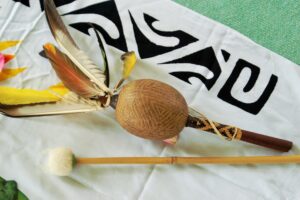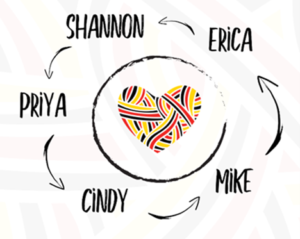Oct 27, 2022

Talking circles, also known as sharing circles, have long been used by Indigenous peoples in Canada, the US, and around the world. They are used to ensure each individual who has gathered in a place has a voice and is fully heard. They are used at the start of a gathering, in the middle, at the end, or are the sole reason for the gathering. They are powerful, and what is shared is often unexpected yet important.
The good news is that many Indigenous peoples have generously shared talking circles with non-Indigenous peoples, knowing the potential they hold. The bad news is that talking circles are often misused and misunderstood by non-Indigenous peoples. This blog has been written to help clarify the sacred nature of this tool and ensure it is used in a respectful and helpful way. We apologize for any generalizations or statements that are harmful in any way – this is certainly not our intention.
Note: The italicized text offers wisdom about the Indigenous peoples practice by Shannon Perez, member of the Sayisi Dene First Nation.
Getting Ready
It need not be complicated. You need a “talking piece” and a circle of chairs in an open place to sit. It is also helpful to ensure your space is quiet, so everyone can hear each other, and that it radiates a feeling of calm. I have been in talking circles around a fire, in an open field, around a dining room table, in a large gymnasium, and around a boardroom table. The room type can vary, however, creating a safe and respectful space that is free from interruptions is important. Confidentiality is paramount and should be stated.
Indigenous peoples often prepare the space by smudging. Smudging is the waving of smoking sage in the air and in front of each individual. This is usually done by an elder either in the group or invited for this specific purpose.
In general, it is believed helpful to have nothing between or in front of the people in the circle. Often you may see a candle or other sacred objects on a low table in the center. In addition, there may be an empty chair in the circle to remember elders and others who are not able to be present at that time.
The Talking Piece
A talking piece is an object that is passed from person to person around a circle to facilitate personal sharing. A variety of items can be used for this purpose: feather, stone, stick, shell, or other item from nature. It is important to intentionally select an object that is simple yet meaningful. I have experienced using a beaded stick, wooden bowl, wrapped feather, and stone.
Indigenous peoples often use an eagle feather or other sacred object gifted to an elder in the community or passed on through generations.
Setting it Up
If non-Indigenous people use a talking/sharing circle it is important to honor the origin of this cultural practice so as to avoid cultural appropriation. Below is some suggested language to share before starting:
“In a few minutes we are going to participate in a sharing circle. This is an ancient cultural practice of Indigenous people of this land and has been gifted to non-Indigenous peoples. It is used to ensure all people in a circle have an equal and honored voice. It is also meant to help each person speak from the heart and speak truth.
Today I have selected an [object] as our talking piece. In a minute, I will pass this talking piece to the person to my left to begin. Whoever holds the talking piece is the only person who can speak. Everyone else is asked to listen deeply and receive all that is shared. This is a time to speak from the heart and listen with the heart.
Once started, the talking piece moves around the circle in one direction. When you receive the piece, pause and consider what needs to be shared. We are in no rush. This is not a time for dialogue, debate, or problem-solving. If it is your turn to speak and you wish to pass, please offer your name and then silently pass the talking piece to the person next to you.
We will go around the circle one time. However, this practice often goes until everyone’s heart is empty.”
There are a variety of reasons to use a talking circle. Sometimes a decision needs to be made and you want input from a variety of voices, other times healing is needed, and other times you want to invite personal sharing on a common topic. Whatever the reason, state it for the group – see this video for how it can be used in the classroom.
To focus sharing, it can be helpful to offer a question or statement clarifying the purpose of the circle. For example: “What has our learning today taught you about yourself? Why is this important?”
The talking piece can be passed to the left or right of the holder of the space.
Indigenous peoples may use similar words to those above, which are often spoken by an elder. Here is another version I (Shannon) use with colleagues.
What to Expect
If participants are new to this way of sharing, they may forget not to respond or react to the person holding the talking piece. Since this is a listening practice, a gentle reminder may be needed from time to time. A safe space for sharing must be ensured.
This sharing is personal and heart-felt. As such, an emotional response is common and should be expected. Placing tissue* in the center of the circle, or close by, can be helpful as well as water to replenish any tears that may fall.**
When to Use a Talking Circle
A talking/sharing circle is helpful when you want to ensure all voices are invited and fully heard. It is not a time for debate, problem-solving, or decision-making. However, it is sometimes helpful to hear from everyone on a challenging topic or issue before or after working on it together. A talking circle can help to ensure all concerns and ideas are heard and no one leaves without having shared their thoughts. The intention is that the person holding the talking piece speaks truth and does not use it as an opportunity to proselytize or grandstand for manipulation.
Indigenous peoples often use a talking circle when truth-telling is needed. A talking circle can take time and should not be rushed. Heart sharing is sacred time.
Using a Sharing Circle Online

Although it is not ideal, we can also use a sharing circle online. There are two ways to do this: 1) The person sharing (and metaphorically holding the talking piece) says someone’s name when they are finished and this continues until each person has had a turn or 2) draw a circle on a sheet of paper with everyone’s names and move around in the order represented. These methods work best with small groups and you will need to ensure that everyone has their preferred name on their screen.
How It Has Been Adapted
Restorative practitioners use talking circles for healing and to build healthy relationships. For this purpose, it is quite common to go around the circle multiple times. For this reason, time is needed.
Facilitators of trainings and meetings often use a talking circle to hear thoughts about the learning. For this purpose, it is common to go around the circle just one time. Sometimes, only one word or sentence is invited, resulting in a short circle experience.
When a talking circle is needed, Indigenous peoples know to make space and time, especially if a group agrees to go around the circle until there is nothing left to say. Everyone knows it may take hours.
A Few Tips to Remember
- Prepare yourself. Your calm and peaceful presence will help the group be fully present with each other and in the circle. Turn your phone off, take time to be rooted and speak with authenticity.
- Prepare the space. Move out unnecessary clutter, arrange a circle of chairs for the number of people expected, and create a center of the circle for the talking piece to be placed. Some find it helpful to place a lit candle in the center as well.
- Prepare the group. Don’t start until the group is calm and ready, and cellphones are turned off. Take time to describe what will happen, how and why, and the origin of this practice. You set the tempo and intention.
- Depending on the purpose of the sharing circle, it may be appropriate to invite an Indigenous elder to lead your circle. This can be especially important when the intention of the circle is healing, reconciliation, or deep wisdom. This will also be expected if many members of the circle are Indigenous.
*There are some teachings that say not to interrupt tears by offering tissue – tears should be free to fall. That is why we suggest placing tissue nearby, that way the person that needs it can get it themselves.
**At large healing and reconciliation events, such as the Canadian Truth and Reconciliation Commission, Indigenous peoples tears can be seen as sacred. For this reason, the soiled tissue may be collected and burned at a sacred fire.
When can you imagine a sharing circle being helpful?
Shannon Perez served as the Canadian Ministries’ Justice and Reconciliation Mobilizer of the Christian Reformed Church of North America for eight years. In the summer of 2021, Shannon transitioned to overseeing the Indigenous Family Centre located in Winnipeg, Manitoba, Canada where they envision healthy connected families. Shannon is a member of the Sayisi Dene First Nation, and lives in Winnipeg with her husband and children. Here are more GLP blogs by Shannon.
Jeanette Romkema is GLP Senior Partner and Partnerships & Network Director. Here are more GLP blogs by Jeanette.
For more resources on talking circles:
- Where Aboriginal Practice and Dialogue Education Meet – a GLP blog
- Classroom Circles – a video (7 min)
- Sharing Circle Guidelines – 1-page resource
- Sharing Circle – a video (1 min)
- Pass the Feather – a resource
- About Sharing Circles – a resource
- The Little Book of Circle Processes by Kay Pranis – a book



